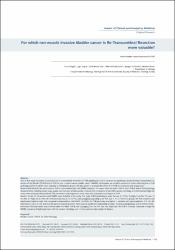For which non-muscle invasive bladder cancer is Re-Transurethral Resection more valuable? Which bladder cancer deserves Re-TUR?
| dc.contributor.author | Akgül, Murat | |
| dc.contributor.author | Doğan, Çağrı | |
| dc.contributor.author | Yazıcı, Cenk Murat | |
| dc.contributor.author | Şahin, Mehmet Fatih | |
| dc.contributor.author | İşal Arslan, Ayşegül | |
| dc.contributor.author | Öznur, Meltem | |
| dc.date.accessioned | 2022-05-11T14:02:49Z | |
| dc.date.available | 2022-05-11T14:02:49Z | |
| dc.date.issued | 2021 | |
| dc.identifier.issn | 2667-663X | |
| dc.identifier.uri | https://doi.org/10.4328/ACAM.20722 | |
| dc.identifier.uri | https://hdl.handle.net/20.500.11776/4500 | |
| dc.description.abstract | Aim: In this study, we aimed to evaluate the re-transurethral resection (re-TUR) pathologies and to compare the pathology results between transurethral resection of the bladder (TUR-B) and re-TUR for non-muscle invasive bladder cancer (NMIBC). Additionally, we aimed to assess the factors affecting the re-TUR pathology and try to define more valuable re-TUR patient groups. We also aimed to evaluate the effect of re-TUR on recurrence and progression. Material and Method: We performed re-TUR in intermediate/high-risk NMIBC patients, 4-6 weeks after the index TUR-B. Both TUR-B and re-TUR pathology characteristics, including tumor stage, grade, size, number, lymphovascular invasion (LVI), carcinoma in situ (CIS), variant pathology, and intermediate/high-risk status were analyzed retrospectively. The recurrence and progression rates were also evaluated according to re-TUR. Results: A total of 78 patients with NMIBC were included in the study. The index TUR-B pathologies were Ta-Low: 6 (7,7%), Ta-High: 5 (6,4%), T1-Low: 14 (17,9%), T1-High: 53 (67,9%). Re-TUR positivity was n: 40 (51 %), and upstaging/upgrading at re-TUR was n: 11 (14 %) in all groups. Re-TUR positivity was significantly higher in high-risk compared to intermediate-risk NMIBC (p:0,026). Re-TUR positivity was higher in patients with hydronephrosis, C15. LVI, differentiation, size (>3 cm), and multiple tumor presence (p<0,05). There was no significant relationship between recurrence/progression and re-TUR (p>0,05). Discussion: Residual tumor was common after the index TUR-B, and upstaging after re-TUR was very important Re-TUR is critically important in high-risk NMIBC, presence of hydronephrosis, CIS, LVI, variant pathology, size (>3 cm). and multiple number of tumors. | en_US |
| dc.language.iso | eng | en_US |
| dc.publisher | Bayrakol Medical Publisher | en_US |
| dc.identifier.doi | 10.4328/ACAM.20722 | |
| dc.rights | info:eu-repo/semantics/openAccess | en_US |
| dc.subject | Bladder Cancer | en_US |
| dc.subject | TUR-B | en_US |
| dc.subject | Re-TUR | en_US |
| dc.subject | Pathology | en_US |
| dc.subject | Progression | en_US |
| dc.subject | Recurrence | en_US |
| dc.subject | Impact | en_US |
| dc.title | For which non-muscle invasive bladder cancer is Re-Transurethral Resection more valuable? Which bladder cancer deserves Re-TUR? | en_US |
| dc.type | article | en_US |
| dc.relation.ispartof | Annals Of Clinical And Analytical Medicine | en_US |
| dc.department | Fakülteler, Tıp Fakültesi, Cerrahi Tıp Bilimleri Bölümü, Üroloji Ana Bilim Dalı | en_US |
| dc.department | Fakülteler, Tıp Fakültesi, Cerrahi Tıp Bilimleri Bölümü, Tıbbi Patoloji Ana Bilim Dalı | en_US |
| dc.identifier.volume | 12 | en_US |
| dc.identifier.issue | 11 | en_US |
| dc.identifier.startpage | 1258 | en_US |
| dc.identifier.endpage | 1262 | en_US |
| dc.institutionauthor | Akgül, Murat | |
| dc.institutionauthor | Doğan, Çağrı | |
| dc.institutionauthor | Yazıcı, Cenk Murat | |
| dc.institutionauthor | Şahin, Mehmet Fatih | |
| dc.institutionauthor | İşal Arslan, Ayşegül | |
| dc.institutionauthor | Öznur, Meltem | |
| dc.relation.publicationcategory | Makale - Uluslararası Hakemli Dergi - Kurum Öğretim Elemanı | en_US |
| dc.authorwosid | akgül, murat/AGE-2468-2022 | |
| dc.identifier.wos | WOS:000732422900013 | en_US |
Bu öğenin dosyaları:
Bu öğe aşağıdaki koleksiyon(lar)da görünmektedir.
-
Tıp Fakültesi Koleksiyonu [2104]
-
WoS İndeksli Yayınlar Koleksiyonu [4789]
WoS Indexed Publications Collection



















